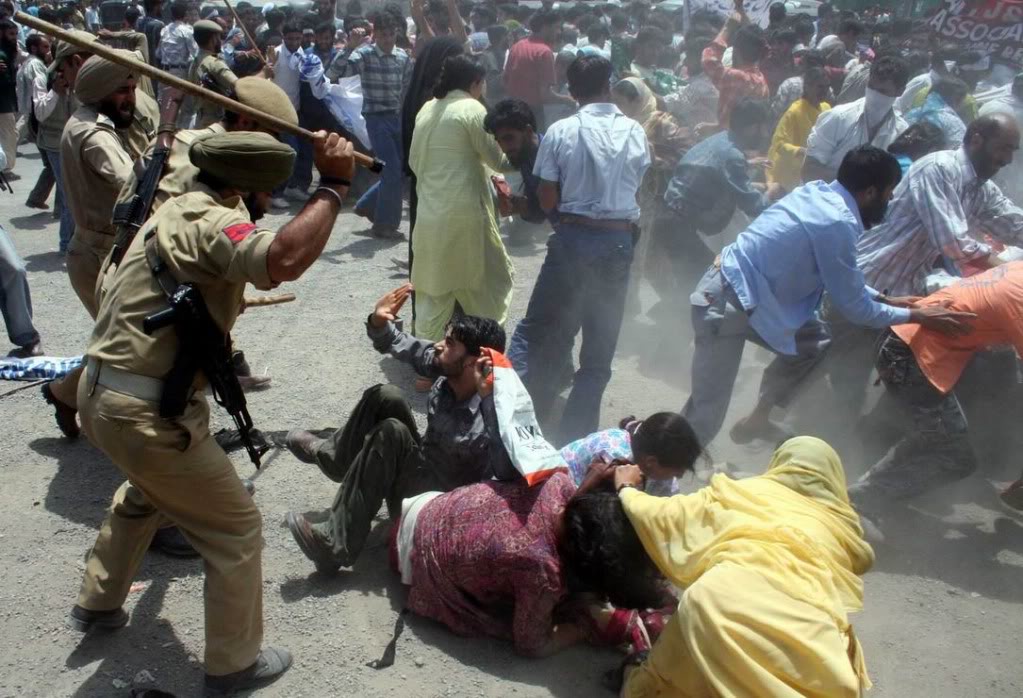Occupied authorities arrested Geelani, Mirwaiz in Srinagar

SRINAGAR, 13 JULY (DNA) – Indian police arrested the All Parties Hurriyet Conference Chairman, Syed Ali Geelani and Mirwaiz Umer Farooq, in Hyderpora area of Srinagar, Wednesday, when he defied curfew and tried to march towards Naqashband Sahib in the city on the occasion of the Kashmir Martyrs’ Day.
Syed Ali Geelani and Hurriyet leaders Mirwaiz Umar Farooq and Muhammad Yasin Malik had jointly given a call for the march towards Martyrs’ Graveyard at Naqashband Sahib to pay tributes to the martyrs of July 13, 1931.
Despite curfew, Syed Ali Gilani Mirwaiz came out of their residence in Srinagar and started to march towards the Martyrs’ Graveyard along with scores of his associates. When they reached at main Airport Road, Indian police swung into action and detained the APHC Chairman and many others and shifted them to Humhama Police Station.
It was on this day in 1931 when the troops of Dogra Maharaja had killed 22 Kashmiris, one after the other, outside the Central Jail in Srinagar. They had gathered in the jail premises to attend the court proceedings against one, Abdul Qadeer, who had asked the Kashmiri people to defy the Dogra rule.
Meanwhile, complete shutdown is being observed in the occupied territory, today, to mark the anniversary of the martyrs of 1931. It is also aimed at registering protest against the killing of innocent Kashmiris by Indian troops and police personnel during the ongoing Intifada. Thirty six people have been killed so far due to the firing of Indian forces’ personnel on peaceful demonstrations since the extrajudicial killing of top commander of Hizbul Mujahideen, Burhan Wani, on Friday.
The occupation authorities continue to impose curfew across the Kashmir Valley and keep Hurriyet leaders under house arrest or illegal detention to prevent demonstrations against the killing of Burhan Wani.
Earlier, the Human Rights Watch (HRW) on Wednesday asked the Indian authorities to credibly and impartially investigate police use of force during violent protests in Occupied Kashmir that have killed more than 30 people and injured hundreds.
Since the killing of Burhan Wani and two other Hizb-ul-Mujahedin members in an armed exchange with the forces on July 8, 2016, demonstrations have occurred in various parts of the state in which protesters have hurled rocks. State security forces have responded by firing pellet guns, teargas, and live ammunition.
“Rock-throwing at demonstrations is serious but does not provide police a free pass to use force against protesters,” said Meenakshi Ganguly, South Asia director at Human Rights Watch. “The Indian authorities need to send a clear message that lethal force is only an option when a life is at imminent risk, and those misusing force will be held accountable.”
While law enforcement officials have a duty to protect lives and property, they should use nonviolent means as far as possible, only use force when unavoidable and in a proportionate manner, and use lethal force only when absolutely necessary to save lives, Human Rights Watch said.
Wani, 22, had a large following among Muslim Kashmiris who shared his demands for secession and an end to abuses by the Indian security forces. After his death, thousands attended his funeral. The protests started soon after, and the government ordered a curfew and blocked the Internet in some places.
The Indian Express reported that hospitals were packed with injured protesters. One ophthalmology ward said that doctors had performed nearly 100 eye surgeries on people with pellet gun injuries. Indian security forces have been using pellet guns as a nonlethal option for crowd control after nearly 120 people were killed during weeks of protests in 2010.
The use of pellet guns since 2010 has reportedly resulted in at least 300 hospitalizations in Srinagar, including 16 cases in which the patient lost their sight completely. The Indian government should publicly order the security forces to abide by the United Nations Basic Principles on the Use of Force and Firearms by Law Enforcement Officials, Human Rights Watch said.
The Basic Principles state that security forces shall “apply non-violent means before resorting to the use of force and firearms,” and that “whenever the lawful use of force and firearms is unavoidable, law enforcement officials shall: (a) Exercise restraint in such use and act in proportion to the seriousness of the offence and the legitimate objective to be achieved; (b) Minimize damage and injury, and respect and preserve human life.” Furthermore, “intentional lethal use of firearms may only be made when strictly unavoidable in order to protect life.”
The Basic Principles further provide that, “[i]n cases of death and serious injury or other grave consequences, a detailed report shall be sent promptly to the competent authorities.” The authorities should not only investigate the use of firearms that resulted in death and injury, but also the use of pellet guns, which can cause serious injury when fired at close range or at an individual’s eyes.
The findings of the investigation should be public and result in appropriate disciplinary action or prosecution. Past lack of accountability for serious human rights violations has been a driving force in the protests. Indian officials have called for restraint and calm by all sides. Security forces have said that they are exercising restraint to disperse protesters.
They reported that 110 security personnel have also been injured in the protests and that one police official drowned when protesters pushed his vehicle into a river. Protest organizers should take steps to deter supporters from engaging in violence, including attacks on law enforcement officers, Human Rights Watch said.
“A major grievance of those protesting in Kashmir is the failure of authorities to respect basic human rights,” Ganguly said. “Ensuring that rights are protected and prosecuting those responsible for abuses would be an important first step.” DNA
————————————————–
Related News

Pakistan, Belarus mark 30 years of the establishment of diplomatic relations
ISLAMABAD, FEB 3 /DNA/ – Foreign Minister Jalil Abbas Jilani has exchanged messages of heartfeltRead More
ANF seizes over 74 kg drugs, 1830 intoxicated tablets
ANF seizes over 74 kg drugs, 1830 intoxicated tablets RAWALPINDI, Dec 14 (APP):Anti-Narcotics ForceRead More


Comments are Closed